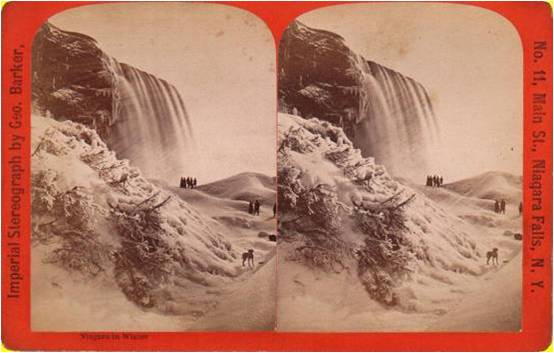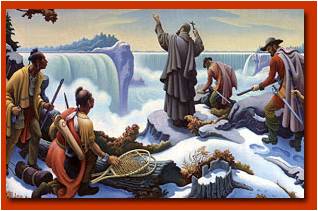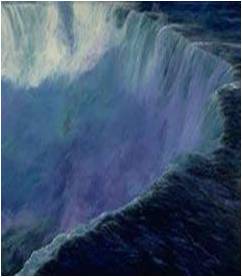by Michelle A. Kratts
Many of the residents of Oakwood Cemetery were deeply connected in some way to the history of Spiritualism in Niagara Falls. In fact some of the great leaders of Spiritualism believed that Niagara Falls, itself, was the source of the Spiritualist movement. At a celebration of the Jubilee of Spiritualism in 1898, Carrie E. S. Twing, a spiritualist author, said:
Some years ago the great Niagara caused those living within sound of the roar of its waters to awake, not because of its noise, but because of its silence…
These next few installments will tell you the most unusual story of Spiritualism in Niagara Falls and about the “silence” that awakened another world to life.

Some believe there is no death, only rebirth, and there are places where there is a communion between these two worlds. Niagara is said to be one of these locations, for there is a phenomenon here that is peculiar to all places of intense beauty. Peter A. Porter said it was the presence of Deity, or Spirit. Others find Niagara a “power point” of energy. Amy Koban, a practicing Spiritualist from Niagara Falls, describes falling water as a natural root cause for paranormal activity. Regardless of our combinations of language, it seems undeniable that the veil between the living and the dead is very thin here. This strange duality of forces—at once divinely beautiful, yet at the same time terrifyingly violent and the embodiment of our greatest fears—has intrigued people for centuries. There is a hypnotic effect that Niagara stamps upon the soul. Some have to tear away from the brink as they feel themselves becoming helpless to their urges. It was inevitable that Niagara would become a haven for the poet, the artist and the mystic. They were the “Sky Holders”, the Medicine Men, the translators of the Divine.
Ever since the very beginning when Father Louis Hennepin, a Recollect missionary who had accompanied LaSalle on the expedition of 1678, wrote the first lengthy account of the falls—“that dreadful gulf (where) one is seized with horror,” people have understood there would be hazards associated with a trip to Niagara. However, it was not only the cataract itself that presented horrific dangers. Early travelers’ accounts describe a rugged and ancient wilderness where Nature and her beasts ruled supreme. There were wolves that roamed in packs of 20 or 30 at a time and “were so fierce as to attack men in the middle of the day.” In the summer months it was said that one may “meet with rattlesnakes at every step and Musquitoes swarm so thickly in the air…that you might cut them with a knife… A Herefordshire man and guide told one traveler that the rattlesnakes were of such an enormous girth that he had once killed one containing twenty four rattles. It was truly a nightmarish landscape.

And yet, there were also rainbows that spread across the daytime skies in Biblical proportions and moon visions that glimmered through the mist. At one time, rainbows were present each morning from ten until noon. John Quincy Adams remarked that “it takes away all language as well as thought, and in this raptured condition one is almost capable of prophesying—standing as it were in a trance, unable to speak.” The moon was a bedtime story, in itself, as it hovered wonderful and curious, above the Niagara River. One hot summer evening in 1787, an English captain who had been visiting Fort Schlosser and the Stedman’s, stopped before the gates of the Fort upon noticing the moon. He had never in his travels seen such a sight as the magic that seemed to unfold around the setting moon over Niagara. It appeared “to rise to a very uncommon height in likeness to a very dark column.” He had witnessed a moon bow, or a lunar bow, a rare phenomenon produced when light reflects off the surface of the moon and shines upon the mist created by the water falls. They are unlikely to occur today because there is less water and therefore less mist due to the diversion of water for electrical purposes and because of the many city lights that crowd up the night sky. At one time, the Maid of the Mist would make moonlight trips for the sole purpose of allowing travelers the opportunity to view the lunar bows. It is not hard to understand how Niagara's unusual and remarkable landscape captivated the early travelers.

Print by Godfrey N. Frankenstein. From "Niagara," in Harper's New Monthly Magazine. August, 1853.
One special visitor, who will forever be connected with Niagara’s mystical past, was Francis Abbott, the Hermit of Niagara. Tall and handsome, wearing a loose gown or cloak of chocolate brown, he was first seen passing through Niagara Falls on the afternoon of June 18, 1829. His singular appearance caught the eye of all who had looked upon him. Carrying only a roll of blankets, a flute, a portfolio, a large book and a small stick, he walked into the hotel and asked the landlady the usual questions about the falls and then about where he might find a library. Immediately, he found his way to the library where he proceeded to borrow some music books and purchase a violin. The librarian was informed that his name was Francis Abbott…and the rest is local folklore and history. Increasingly, he became completely and utterly bewitched by the falls. He found his way to the library often and each time he spoke with the librarian he informed him that he would be staying a little longer than he had originally planned. Eventually, as time wore on and he remained, he built himself a rustic hut upon Goat Island. He revealed that it was his plan to live as a solitary hermit. The proprietor of the island allowed him to stay at the only dwelling then on the island where a family lived. He ate very little and lived the life of an ascetic monk. He lived such as this for about 20 months and would often be seen with his guitar, supported with a silken sash, walking the banks of the whirlpool. His music was strange to the ears of those who listened. They came from their homes and he would just as soon walk away.
Eventually, as time went on, he built a cottage of his own near the high bank of the river—in full view of the falls. He lived here about 2 months with only his pet dog. Much of his time was spent in quiet solitude and meditation. Many grew accustomed to his peculiarities—how he loved to bathe in the cascades between Goat Island and the Three Sisters Islands, even in the coldest weather, and how he made a daily practice of walking over a piece of timber that extended over the Terrapin Rocks and 12-15 feet over the precipice of the falls—sometimes hanging over the chasm by his hands and feet for 15 minute intervals. He was known to write quite often, mostly in Latin, but destroyed his works just as fast as he created them.

Francis Abbott disappeared on June 10, 1831. The last anyone saw of him was the ferryman at 2:00 in the afternoon. Only his clothes were found on the rocks. On June 21, his body was identified at Fort Niagara. The next day he was interred in the burial ground at Niagara Falls. He was eventually removed to Oakwood Cemetery and his gravesite remains one of the most popular sites. Following his death, the following inscription was found chiseled upon a rock on Luna Island and believed to have been written by Abbott, himself: All is Change, Eternal Progress, No Death. He was about 28 years of age at the time of his death and a most spectacular curiosity and precursor to the spiritual history of Niagara Falls.

Grave of Francis Abbott in Oakwood Cemetery
Another most singular individual who found his way to Niagara was Godfrey N. Frankenstein. Born in Hesse-Darmstadt, Germany, in 1820, he would become “the painter of Niagara Falls.” It was said that as a child he was so strange as to gleefully await the slaughter of the pigs on his father’s farm so that he might “collect a quantity of blood for paint.” And just as Francis Abbott had been enamored of Niagara, young Frankenstein found himself “so charmed with their grandeur and beauty” that he spent much of his life in Niagara Falls and painting the scenery. He developed a growing fascination, or “almost an obsession with Niagara Falls. He “made the study of the great cataract a labor of love.” He summered and wintered by it; painted it by day and by night; capturing every angle and each nuance. He was well known even to paint as “the grey rocks wore an icy robe and the spray congealed into icicles upon his stiffened garments.” Although he painted over one hundred easel paintings of the falls, he is most well known for his panorama, “Niagara.” “Niagara” was painted upon a strip of canvas that was over 1,000 feet long and nine feet high. It rolled from one wooden spindle to the next, with the assistance of Frankenstein’s siblings who had helped to arrange the panels systematically. It was first exhibited in the old City Hall in Springfield, Ohio, before touring much of the country. Some historians believe that Frankenstein’s panorama of Niagara was the very first inception of a motion picture. The panorama was unique as it provided a sort of “cinematic” effect as its size and portrayals made viewers feel as if they were swallowed up into the giant cataract, themselves. There was music and drama to accompany its viewing. It grew to intense popularity. “Owing to the increased desire to see this remarkable work of art and to enable ladies and children to see it, Frankenstein’s Moving Panorama of Niagara will hereafter be exhibited both morning and night…admission 50 cents.”

Print by Godfrey N. Frankenstein. From "Niagara," in Harper's New Monthly Magazine. August, 1853.
Frankenstein had also included inserts of terror, such as the collapse of the Table Rock and a boatman’s fatal plunge—which horrified, as well as entertained, the viewers. Commentators were well aware of the strong theme of death which prevailed throughout much of Frankenstein’s work on Niagara. “The spectre of death seemed implicated in the medium’s own mode of representation; like a cadaver…the canvas resembles a living being…and yet there is a paradox in the close resemblance to death…”
Truly, a panorama such as “Niagara” was a giant among works of art and Niagara was the perfect subject. The artist at Niagara had become not unlike the “Sky Holder,” or interpreter of the divine.
I have also personally experienced the translation of Niagara’s beauty into art a few years ago when Thomas Asklar, a renowned artist of today’s Niagara, a modern day “Sky Holder,” spent a great deal of time unloading his massive renderings of the cataract into the community room at the Lewiston Public Library for a display. Some pieces were so large they could only be propped against the wall. When everyone had gone and I was left to myself, I sat in a room filled from the floor to the ceiling with Niagara and I had the unmistakable feeling rush through me—it was as if I were really there and I could almost hear the water and then that familiar fear and trepidation took my breath away.

Western Front, by Thomas Paul Asklar

Whispering Wind, by Thomas Paul Asklar
Frankenstein died from a cold on February 24, 1873. He is buried in Spring Grove Cemetery in Cincinnati. Unfortunately the behemoth panorama, “Niagara,” is also gone. It is believed that he had stored it in Black’s Opera House in Springfield which burned to the ground in 1903. “Whatever its merit, it no doubt long ago passed into the limbo of the forgotten.”

Print by Godfrey N. Frankenstein. From "Niagara," in Harper's New Monthly Magazine. August, 1853.
The mid 19th century swept through western New York with a frenzy that had never been seen before. There were new emotions arising as the dust settled from the late wars and as a new nation sought to create a persona. The Frankenstein panorama was noted as being a true representation of our nationhood. It portrayed the indomitable and reckless spirit—the passion and pathos of the American-- in its panels of Niagara Falls. There was an incessant longing in the American for an understanding of this strange new position, an identity, among the nations of the world. Much of western New York was still frontier and spiritual needs were often left unanswered as clergy were scarce. Folk movements grew at an alarming pace. The grounds were fertile for an awakening. Niagara was a part of what became known as the “Burned Over District.” This term referred to the section of the country where new religions were founded and it was tied in closely with other movements such as the Women’s Rights Movement and Abolitionism. It was not too far from Niagara, in Palmyra, New York, where Joseph Smith was said to have been visited by the angel, Moroni, and the Latter Day Saint religion was born. The Millerites, the Shakers and various Utopian experiments were coming to life and gaining a stronghold in this region. Most importantly, on March 31, 1848, the modern Spiritualist movement was born when the Fox sisters in Hydesville, New York, began communicating with “Mr. Splitfoot,” the spirit of a peddler who had been murdered and buried under their home. Perhaps it was merely a coincidence that the day before the event in Hydesville, on March 30, 1848, the great Falls at Niagara were silenced because of a natural phenomenon that sent many panicking that the end of the world was coming. An ice jam had temporarily cut the flow of the water. Eventually a crack formed and the water was flowing again, but not before hundreds of fascinated people ventured out in the riverbed.

The Fox Sisters of Hydesville, New York
And Niagara did fascinate. Here, the space between heaven and earth was quite visibly smaller. Niagara was a symbol for the fugitive slave of the great power of the promise of freedom. Thousands made their way to this border-land with Canada and found new life just a stone’s throw across the water. However, it was also a point of energetic conflict as Niagara was the location at which bounty hunters sought their rewards. There were local men and women within the community who assisted in the Underground Railroad, and there were those who profited from assisting the bounty hunters. It was no secret that the Abolitionist movement was deeply embedded in Spiritualism. Prominent leaders such as Harriet Beecher Stowe, William Lloyd Garrison and Thomas Garrett were professed Spiritualists. Many fugitives were brought to freedom through Niagara by Harriet Tubman, an intensely spiritual woman, herself. She was known to have been led by dream visions, to have spoken to God, Himself. Many knew her to be a “firm believer in spiritual manifestations.” In fact, her biographer, Sarah Bradford, had a difficult time portraying her character as she tried desperately to limit revealing her strange behaviors and beliefs for she was certain that its mere mention could possibly discredit her.
Look for Part 2 of “When Things of the Spirit Come First”…Learn about the famous psychics who found Niagara Falls “fascinating,” debates over the survival of man held in local establishments, a most unusual occurrence in the yards of the Central Railroad near the Suspension Bridge, and ghosts on the Maid of the Mist….